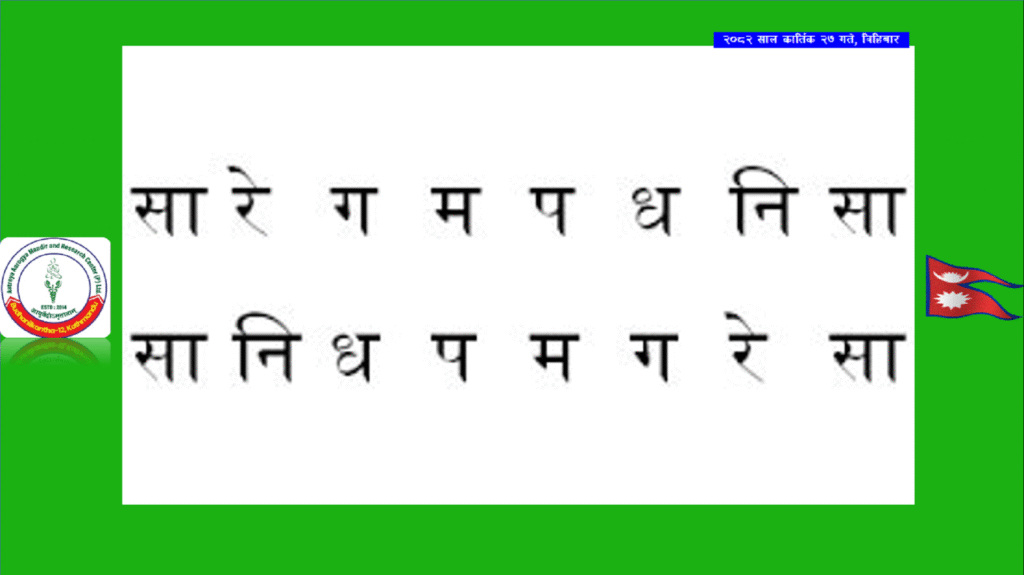Nepali Classical Music -Sa Re Ga Ma Pa Dha Ni Sa – The Sacred Science of Sound, Life, and Consciousness
Table of Contents
Introduction
“Sa Re Ga Ma Pa Dha Ni Sa” is not just a sequence of musical sounds – it is the vibration of the universe expressed through human consciousness. Every note represents a distinct energy frequency that harmonizes the body, mind, and soul. Originating from the Vedas and refined by ancient musicologists, these seven notes form the foundation of Indian classical music and sound-based healing traditions.
Vedic and Historical Origins
In the Sama Veda, the hymns were sung melodiously – giving rise to the earliest system of Saptasvara (seven notes).
“Nādo’sya Paraṁ Brahma” – Sound is the Supreme Consciousness.
Bharata Muni’s Nāṭyaśāstra (circa 200 BCE) first classified these seven notes scientifically, later expanded in Śārṅgadeva’s Sangeeta Ratnakara. These texts explain how sound vibrations mirror the cosmic order (Rita), forming the spiritual science of Nāda Yoga.
The Seven Notes and Their Natural Resonance
Together, they complete a full saptak (octave), symbolizing the cycle of creation and dissolution — from Sa to Sa, as the universe moves from manifestation to return.
Connection with the Human Body and Chakras
Each note corresponds to one energy center (Chakra) in the human body:
Practicing these notes through singing or meditation aligns and balances all seven chakras, creating physical and emotional equilibrium.
Naada Yoga – The Yoga of Inner Sound
Nāda Yoga teaches that the entire cosmos is vibration.
“Nādaḥ bindu kalātmikā” — Sound and consciousness together form creation.
Through the repetition of “Sa Re Ga Ma Pa Dha Ni Sa,” the practitioner tunes inward, transcending external sound (Ahata Naada) to experience the inner sound (Anahata Naada).
This leads to deep meditation and union with the Supreme Consciousness (Samadhi).
Planetary and Cosmic Correlation
This ancient system connects the microcosm of human sound with the macrocosm of planetary vibrations, reflecting the Vedic idea – Yatha Pinde Tatha Brahmande (“As in the body, so in the cosmos”).
Ayurveda and the Healing Power of Music
Ayurveda recognizes music as Manah-Prasādana Chikitsā – therapy that purifies and stabilizes the mind.
Regular exposure to harmonious sound can balance the Tridosha, improve mental focus, reduce anxiety, and promote rejuvenation (Rasayana).
Scientific and Neurological Insights
Modern neuroscience confirms that sound frequencies affect brainwave activity, hormonal balance, and heart coherence.
EEG and MRI studies show that listening to Indian classical music enhances alpha and theta brain waves, reduces stress, and improves emotional resilience.
Thus, ancient Naada Yoga aligns perfectly with today’s sound therapy and vibrational medicine.
Spiritual Interpretation
The seven notes mirror the journey of consciousness:
Sa → Birth and grounding
Re → Emotion and movement
Ga → Harmony and joy
Ma → Compassion and balance
Pa → Expansion and divine order
Dha → Enlightened vision
Ni → Nearness to liberation
Sa → Union with the Supreme
Thus, Sa Re Ga Ma Pa Dha Ni Sa symbolizes the eternal rhythm of the soul — from manifestation to merger with the Infinite.
Aatreya Aarogya Mandir Perspective
At Aatreya Aarogya Mandir, we view Sound (Naada), Life Energy (Prana), and Consciousness (Atman) as the three foundations of health.
When sound is pure, the mind becomes still, the doshas balance, and the soul experiences harmony.
“Sa Re Ga Ma Pa Dha Ni Sa” therefore is not just music – it is Ayurveda Naada Meditation, a pathway to healing and enlightenment.
Conclusion
“Sa Re Ga Ma Pa Dha Ni Sa” represents the cosmic vibration of existence – where science, spirituality, and healing meet.
By practicing or even listening mindfully to these notes, one aligns with universal rhythm, awakens intuition, and experiences holistic well-being.
“Nāda Upāsanā Paramaṃ Dhyānam” – Worship of sound is the highest meditation.
संगीत, नादयोग एवं आयुर्वेद सम्बन्धी संस्कृत श्लोकहरू
Here are Sanskrit shlokas related to Sangeet (Music), Naada Yoga and Ayurveda, along with their English translations – beautifully connecting sound, consciousness, and healing as understood in the Vedic-Ayurveda tradition:
नादब्रह्म (Naada as the Supreme Reality)
नादोऽसि सर्वभूतानां नादोऽसि परमार्थतः ।
नादेन विन्यस्तमिदं विश्वं नादे निलीयते पुनः ॥
Translation:
You are the sound (Nāda) pervading all beings; indeed, sound is the supreme essence.
This universe is created through sound and ultimately dissolves into it.
संगीतस्य योगः (Union through Music)
गीतं वाद्यं नृत्यं त्रयं संगीतं उच्यते ।
त्रयमेतत्समायुक्तं ब्रह्मानन्दं प्रपद्यते ॥
Translation:
Song, instrumental music, and dance — these three together form “Sangeeta.”
When united in harmony, they lead one to the bliss of the Supreme Being (Brahmananda).
सप्तस्वर स्तुति (Praise of the Seven Notes)
सा रे ग म प ध नि इति सप्तस्वरा मता: ।
एतेषां संयुतं गीतं ब्रह्मानन्दप्रदं भवेत् ॥
Translation:
The seven notes – Sa, Re, Ga, Ma, Pa, Dha, Ni — are the foundation of all melodies.
When played in unison, they produce the bliss of divine consciousness.
नादयोग (Yoga of Sound)
नादः परं ब्रह्म कथं नु वर्ण्यः ।
यत्र प्रविष्टो न पुनः प्रवर्तते ॥
Translation:
Sound (Nāda) is the supreme Brahman — it cannot be fully described.
One who merges into it transcends all worldly existence.
राग–भाव–प्राण सम्बन्धः (Connection of Raga, Emotion and Life)
रागः शरीरं संगीतं भावोऽस्य हृदयं स्मृतः ।
स्वराः प्राणाः संश्रिता यस्मिन् स जीवति सदा नरः ॥
Translation:
Rāga is the body of music, emotion is its heart, and notes (Swaras) are its life-breath.
One who realizes this harmony lives in eternal joy.
आयुर्वेदे नादसिद्धान्तः (Naada in Ayurveda)
नादः प्राणसमो ज्ञेयः प्राणो नादसमः स्मृतः ।
यत्र नादः स्थिरो देहे तत्र रोगो न जायते ॥
Translation:
Naada (vibrational sound) is equivalent to Prana (vital energy); Prana itself manifests as Naada.
Wherever sound-vibration flows harmoniously in the body, disease cannot arise.
ध्वनि–चिकित्सा सिद्धान्तः (Principle of Sound Therapy)
स्वरसंयोगसंयुक्तं गीतं मनसि शान्तिदम् ।
रोगशमनमायुष्यं बलं यश्च प्रकल्पयेत् ॥
Translation:
Music composed of harmonious notes brings peace to the mind,
destroys diseases, enhances longevity, and bestows strength and glory.
सरस्वती वन्दना (Invocation to the Goddess of Music)
या कुन्देन्दुतुषारहारधवला या शुभ्रवस्त्रावृता ।
या वीणावरदण्डमण्डितकरा या श्वेतपद्मासना ॥
नाद ब्रह्म – Sound is the Supreme Reality
नादः परं ब्रह्म ततः प्रवर्तते जगत्।
नादे स्थिता हि सर्वेषां सिद्धिः स्वर्गापवर्गयोः॥
(नादबिन्दु उपनिषद् १.५)
Meaning:
Sound (Naada) is the Supreme Brahman; from it the universe arises. All perfection and liberation rest in the realization of this sound.
सप्तस्वर वर्णन — The Seven Divine Notes
षड्जो ऋषभगान्धारो मध्यमः पञ्चमस्तथा।
धैवतं निषादश्च सप्त स्वराः प्रकीर्तिताः॥
(सङ्गीतरत्नाकरः, सारङ्गदेवः)
Meaning:
Ṣaḍja (Sa), Ṛṣabha (Re), Gāndhāra (Ga), Madhyama (Ma), Pañchama (Pa), Dhaivata (Dha), and Niṣāda (Ni) – these seven are the sacred musical notes.
स्वर र सृष्टि सम्बन्ध – Sound as the Source of Creation
शब्दब्रह्म समुत्पन्नं नादब्रह्म स्वरात्मकम्।
तस्मान्मूलं जगत्सर्वं नादे निहितमव्यये॥
Meaning:
The eternal sound (Śabda Brahma) manifests as Nāda (vibration and tone). All creation rests upon this imperishable foundation of sound.
संगीतं त्रयमौषधम् – Music as Healing in Ayurveda
संगीतं ध्यानमौषधं हास्यं च मनःप्रसादनम्।
त्रयं औषधमित्याहुर्मनसः क्लेशहारकम्॥
Meaning:
Music, meditation, and laughter — these three are said to be medicines that purify and heal the mind.
नादयोग साधना — The Inner Sound as Meditation
अहातोऽपि हि यो नादः सोऽनाहत इति स्मृतः।
तेन योगी समाधत्ते चित्तं ब्रह्मणि नित्यशः॥
Meaning:
The yogi who listens to the unstruck inner sound (Anāhata Nāda) merges his consciousness continuously into the Divine.
स्वर र ग्रह सम्बन्ध – Planetary Harmony of Notes
सूर्यः षड्जं च रक्षेतु चन्द्रः ऋषभमाह्वयेत्।
मङ्गलः गान्धरं चैव बुधो मध्यमं ततः॥
गुरुः पञ्चमं चोक्तः शुक्रः धैवतमेव च।
शनिः निषादं रक्षेतु सप्तग्रहाः स्वरात्मकाः॥
Meaning:
The Sun protects Ṣaḍja, the Moon inspires Ṛṣabha, Mars governs Gāndhāra, Mercury rules Madhyama, Jupiter guards Pañchama, Venus influences Dhaivata, and Saturn harmonizes Niṣāda.
त्रिदोषसन्तुलनं सङ्गीतद्वारा – Balancing the Doṣas through Music
वातं पित्तं कफं चैव स्वरैः संतुल्यते नरः।
मृदु तीक्ष्णस्वरैः प्रीत्या रोगनाशो भवेद्ध्रुवम्॥
Meaning:
By the modulation of soft and sharp notes, one balances Vāta, Pitta, and Kapha; music indeed becomes a tool for healing.
नादोपासना — The Worship through Sound
नादोपासना परं ध्यानं नादे ब्रह्म प्रतीयते।
यः नादं वेत्ति सो वेत्ति ब्रह्मणो हृदयं परम्॥
Meaning:
Meditation on sound is the highest form of worship. He who realizes the essence of Nāda perceives the very heart of Brahman.
स्वर र चेतना सम्बन्ध — The Journey of Consciousness
सा रे ग म प ध नि सा इति स्वरक्रमेण च।
जीवस्योन्नतिमार्गोऽयं ब्रह्मलाभस्य साधनम्॥
Meaning:
The progression of notes “Sa Re Ga Ma Pa Dha Ni Sa” symbolizes the soul’s ascent toward union with the Divine.
समापन — Harmony as the Goal of Life
नादं विदित्वा यः साधकः शुद्धचित्तो भवेत्।
तस्य देहे मनो नित्यं ब्रह्मभावं प्रपद्यते॥
Meaning:
When the seeker understands the sacred vibration of Nāda, his mind becomes pure and he attains divine consciousness within the body itself.
नादब्रह्म
नादोऽसि सर्वभूतानां नादोऽसि परमार्थतः ।
नादेन विन्यस्तमिदं विश्वं नादे निलीयते पुनः ॥
Meaning:
Sound (Naada) is the essence of all beings and the supreme truth. The universe originates from sound and ultimately dissolves into it.
संगीत महिमा
रागाद्याः संगीतशास्त्रे भावयन्ति मनो नृणाम् ।
संसारदुःखनाशाय साधनं परमं स्मृतम् ॥
Meaning:
Melodious tunes and rhythms elevate the mind of human beings – music is regarded as a supreme means for removing the sorrows of worldly life.
सप्तस्वर स्तुति
सा रे ग म प ध नि इति सप्तस्वरा मता: ।
एतेषां संयुतं गीतं ब्रह्मानन्दप्रदं भवेत् ॥
Meaning:
The seven notes – Sa, Re, Ga, Ma, Pa, Dha, Ni – when harmoniously combined, bestow the bliss of Brahman (supreme consciousness).
सरस्वती वन्दना
या कुन्देन्दुतुषारहारधवला या शुभ्रवस्त्रावृता ।
या वीणावरदण्डमण्डितकरा या श्वेतपद्मासना ॥
Meaning:
Salutations to Goddess Saraswati – adorned in white garments, holding the veena, seated on a white lotus – the goddess of sound, knowledge, and music.
राग–भाव सम्बन्ध
रागः शरीरं संगीतं भावोऽस्य हृदयं स्मृतः ।
स्वराः प्राणाः संश्रिता यस्मिन् स जीवति सदा नरः ॥
Meaning:
Rāga is the body of music, emotion (Bhāva) its heart, and the notes (Swaras) are its life-force — the person who realizes this lives in eternal joy.
नादयोग
नादः परं ब्रह्म कथं नु वर्ण्यः ।
यत्र प्रविष्टो न पुनः प्रवर्तते ॥
Meaning:
Nāda (divine sound) is the supreme Brahman — once the consciousness merges into it, it does not return to worldly turbulence.
श्रुति–राग–तत्व
श्रुतयो रागभेदाश्च तालो लयसमन्वितः ।
एष संगीतयोगोऽयं मोक्षमार्गस्य साधनम् ॥
Meaning:
Shruti (microtones), Raga (melodic patterns), and Tala (rhythm) together form Sangeeta Yoga — a spiritual discipline leading toward liberation (Moksha).
देवतास्वर सम्बन्ध
सा रे ग म प ध नि इत्येताः स्वरदेवताः स्मृताः ।
एषां स्मरणमात्रेण पापं नश्यति निश्चयम् ॥
Meaning:
Each of the seven notes is considered divine – mere remembrance of these swaras destroys all impurities of the mind.
संगीतयोगः
गीतं वाद्यं नृत्यं त्रयं संगीतं उच्यते ।
त्रयमेतत्समायुक्तं ब्रह्मानन्दं प्रपद्यते ॥
Meaning:
Song, instrumental music, and dance — these three together form Sangeeta. United, they become a path to divine bliss (Brahmananda).
ओंकार–सप्तस्वर सम्बन्धः
ओंकारो मूलं नादानां सा रे ग म प ध नि ।
तेषां संयोजनं गीतं परमात्मप्रकाशकम् ॥
Meaning:
Om is the root of all sound — the seven notes (Sa, Re, Ga, Ma, Pa, Dha, Ni) emerge from it. When they unite in harmony, they reveal the Supreme Self.


